Choosing a gravel tire can be a daunting process, and Teravail wants to make it easier. Since 2015, the brand has been designing all-terrain tires for adventure and the path less traveled.
Below, we dive into how riders can optimize their bikes for different terrain — and highlight five tires from Teravail that can handle that terrain.
Defining your riding style
To start, we recommend that cyclists define their riding style, priorities, and goals before landing on a tire. To help a cyclist define their riding style, we’re putting them into three different categories: racers, explorers, and cruisers. (More on this below.)
Before you settle on a tire for your ride, define what kind of rider you are, the terrain you’re going to be riding, and what you prioritize — speed, comfort, or versatility/durability. From there, you can hone in on products and choose the gravel tire that will suit you best.
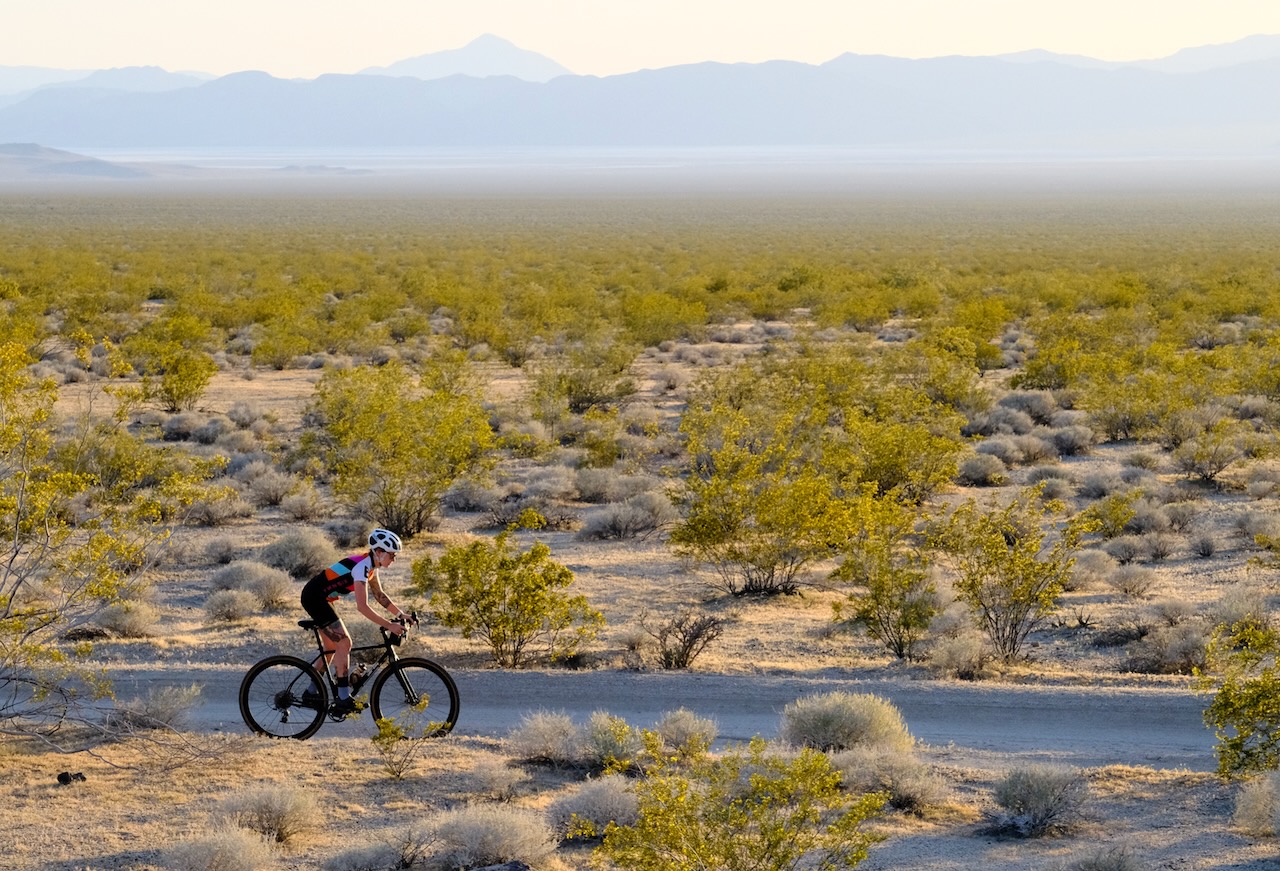
Racing vs. Exploration vs. Cruising
Let’s get further into the three types of riders we named above.
A racer looks to cover ground as fast as possible. Speed is the goal, and sometimes this comes at the cost of comfort, compliance, and durability. They should choose a tire that gives them the best chance of completing a course speed record.
An explorer, well, explores. This could be a bikepacker or thrill-seeking gravel rider who gets off the beaten path, into the woods, through mud, down some steeps — you name it. This type of rider should choose a tire that will perform on all sorts of terrain and rugged trails without risking flats, falls, or loss of air.
A cruiser takes a more utilitarian approach to their bicycle. This type of rider might crank a few miles to work in the morning, then throw on the spandex and crush 20-plus miles on pavement or gravel in the afternoon. A cruiser should choose a tire that can do it all — something that can make the commute, keep up with the peloton on pavement, and be ready for adventure when it’s time to hit the dirt.
Understanding terrain
Before selecting a tire, a cyclist should take inventory of their chosen terrain or course. This will optimize their performance.
Pavement and hardpack trails are more predictable terrain types with fewer hazards. These types of courses don’t demand a tire with too much durability or tread. So when prioritizing speed, riders can generally opt for a tire that’s lighter-weight and slick.
Gravel roads fall between paved/hardpack and rocky off-road trails. For a gravel road, you might get the best performance out of a tire with decent width, tread, and durability. You’ll want something that provides traction, but you probably don’t need a tire on the XC-MTB end of the spectrum.
For rocky trails, muddy trails, or pure exploration, a beefed-up tire with rigid sidewalls and good mud shedding is your best bet for a successful ride. You want a tire that will grip the terrain, handle hazards, and provide stability through loose or wet sections of trail.
Of course, there are scenarios and trail types outside the three general terrain types we’ve listed. But the demands of the ride ahead will tell you what to look for in a tire.
What to look for in a tire
Three key considerations when you’re choosing a tire are tread, width, and construction.
First, tread refers to the design patterns on a tire that come into contact with the road, and they directly correlate to traction, control, and stability. Riders should opt for different tire treads to optimize their performance on different terrain.
For example, if you’re riding on pavement or hardpack, a tire with smoother center tread will create a low rolling resistance and more surface area contact for better traction.
On the opposite end of the spectrum, if you’re riding rough, rocky, muddy, or loose sand trails, a wider tire with a more aggressive tread pattern and larger tread knobs — the raised rubber elements on the tire — is the better choice.
Second, width is another differentiating factor in tire design that contributes to stability, speed, and comfort. Thinner tires are lighter but may sacrifice durability and traction. Wider tires are heavier, but what they lack in light weight they make up in traction, stability, and comfort. Additionally, wider tires tend to have a more substantial construction, which generally results in greater durability.
Finally, the construction of a tire will determine puncture resistance, weight, and longevity. Cyclists riding on pavement or hardpack that prioritize speed might opt for a lightweight tire with less rolling resistance, whereas cyclists taking on more variable terrain will be less concerned with weight and favor durability.
Teravail offers two tire casings: Durable bead-to-bead and Light & Supple. Durable bead-to-bead is the more robust composition, with a woven nylon layer in the sidewall and tread cap to protect the tire against punctures, abrasions, and lacerations. Light & Supple will roll more comfortably and weigh less, but it offers less puncture protection.
The Durable casing is a better choice for those riding and exploring gravel that’s more varied and challenging. If you know the terrain you’re riding is rugged with side wall-cutting rocks, it’s best to be equipped with a thicker casing to avoid flat tires. The Durable option is still fast rolling and could work well for ultra-endurance or adventure riding, providing a bit more insurance against any hazardous terrain.
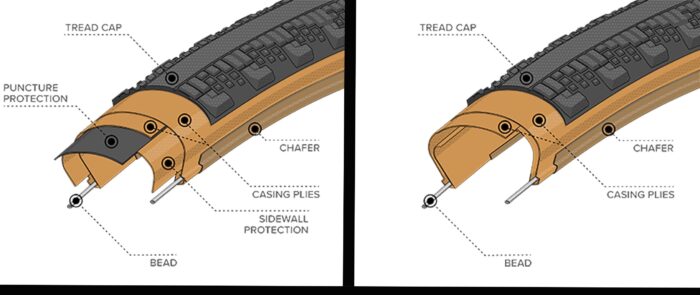
The Teravail Gravel Line
Below, we get into the nitty-gritty of five Teravail tires you might want to consider for your gravel setup.
Teravail Rampart
The Teravail Rampart is a dry-condition and mainly road or pavement tire. The tread is minimal, but it packs in more volume than most pure road tires. According to the brand, this tire is at home on decaying pavement, hardpacked dirt, and light gravel.
The center tread is smooth and fast-rolling for wide open roads and pavement. As you move to the side of the tire, the lugs have 3-2-1 siping for traction on all road surfaces and weather conditions.
For those looking to maximize efficiency, the Rampart comes in both Durable and Light & Supple casings. Both options have the same tread (or lack thereof), but the Durable casing has an extra protective layer to stave off cuts and flats.
Rampart Details
- Designed for: Pavement, cobbles, and classics style terrain
- Casing: 60 tpi folding-bead
- Available in Durable or Light & Supple options
- Available with Black or Tan sidewalls
- Tubeless-compatible
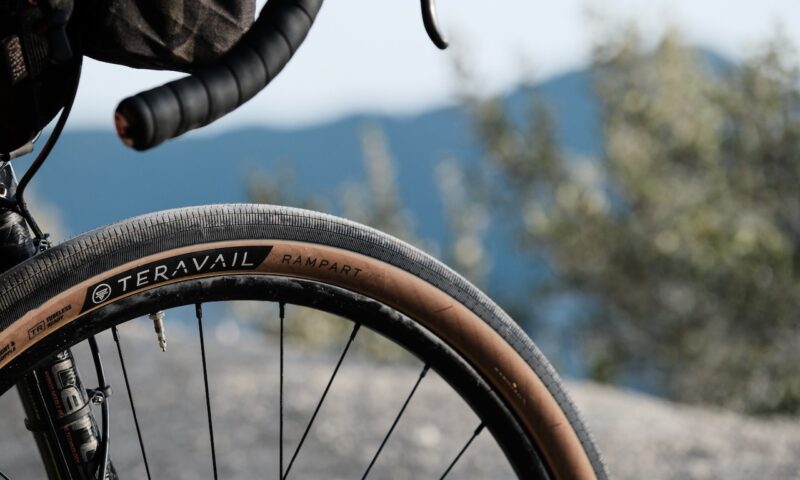
Teravail Washburn
The Teravail Washburn is a fast-rolling tire with a slick center tread as well as beefed-up lugs and treads on the side. Teravail designed the Washburn to provide extra traction while cornering and help a rider maintain speed on flats, pavement, or hardpack.
The lugs are tightly spaced toward the center of the tire and gradually become more spaced out toward the sidewall. This lug style helps keep riders upright on the road without fading too aggressively.
The Washburn is a tire to consider for rides with mixed terrain — perhaps some pavement blended with back road gravel exploration.
Washburn Details
- Designed for: Adventure racing/riding with equal parts pavements and dirt
- Casing: 60 tpi folding-bead
- Available in Durable or Light & Supple options
- Available with Black or Tan sidewalls
- Tubeless-compatible
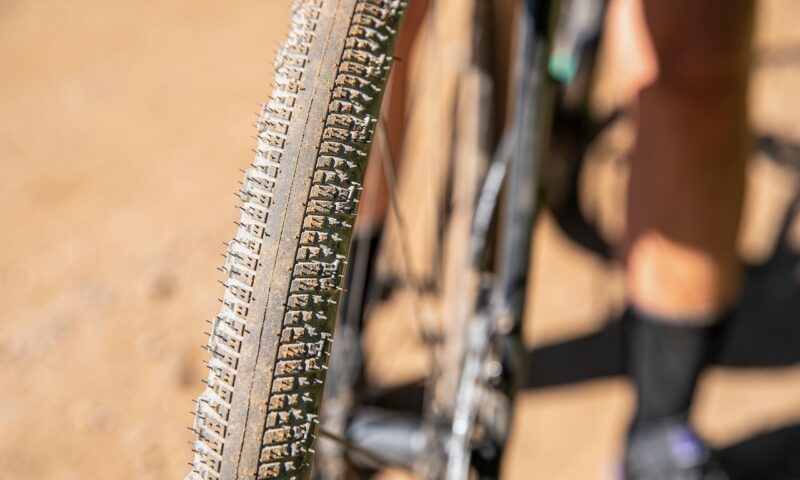
Teravail Cannonball
When Teravail designed the Cannonball, its aim was to make the Swiss Army knife of gravel tires.
The Cannonball offers a balanced blend of durability, traction, and speed. The center lugs are raised and ramped for efficient rolling, and the diamond-shaped lugs squeeze in for grip as they contact dirt, then back out to shed debris. And the side and shoulder transition lugs are spaced and vary in height to boost traction and confidence.
It sees the addition of L-shaped side lugs, which are typical in cyclocross tires. The Cannonball digs in for grip while braking through corners but rolls quickly when a rider lets off the brakes.
The ethos of the Cannonball is all-around gravel. It will perform well on most surfaces, claims the brand.
Cannonball Details
- Designed for: Classic gravel, limestone, mixed terrain
- Casing: 60 tpi folding-bead
- Available in Durable or Light & Supple options
- Available with Black or Tan sidewalls
- Tubeless-compatible
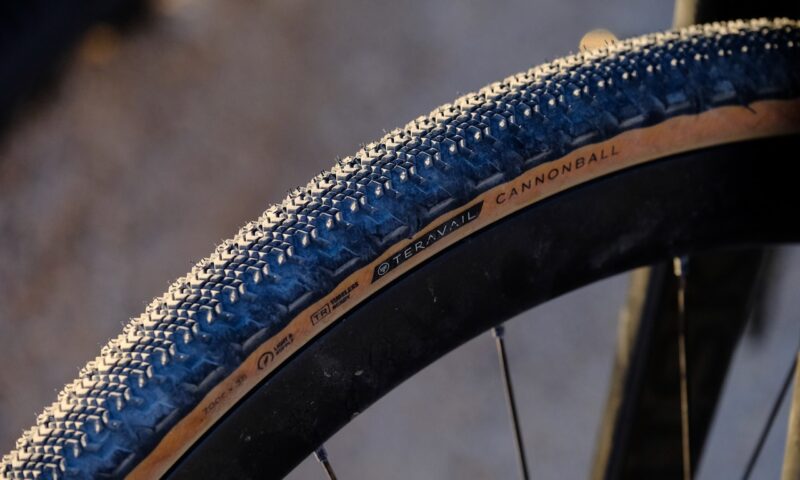
Teravail Sparwood
The Teravail Sparwood is a spring gravel tire with a fast-rolling tread that can mix it up in some mud and thick, heavy, wet gravel.
The initial idea of the Sparwood was a long-distance, mixed-terrain tire, but it succeeded as a gravel race tire because of the similarities in those disciplines, according to the brand. Its design aims for a hard-charging tread with rolling efficiency mixed with durability and the ability to shed mud when the road hits.
The tread of the Sparwood is a slightly raised, tightly spaced center line tread that is ramped for a better rolling economy. Unlike the Cannonball, the Sparwood uses diamond- and chevron-shaped transition lugs. The diamond-shaped lugs on the side and shoulder give a predictable grip that sheds dirt, says Teravail. Paired with L-shaped knobs for braking stability, the Sparwood is a slightly more aggressive tread than the Cannonball.
Sparwood Details
- Designed for: Classic gravel course, chunky terrain with rocks, slightly wet, saturated terrain
- Casing: 60 tpi folding-bead
- Available in Durable or Light & Supple options
- Available with Black or Tan sidewalls
- Tubeless-compatible
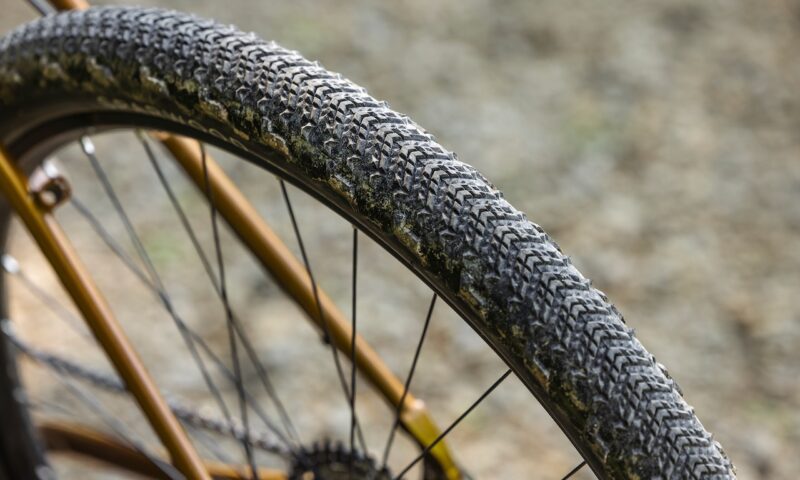
Teravail Rutland
The Teravail Rutland is built to tackle the gnarliest of terrain, according to the brand. Taking inspiration from cross-country mountain bike tires, the Teravail Rutland has a fast-rolling tread, ample mud clearance, and sharp, staggered knobs to dig into fresh, damp soil or clay.
The tread on the Teravail Rutland is the most aggressive the brand offers in its gravel line, but it’s still reasonably fast-rolling compared to a full-on “mud” tire. The tire profile is round, even with the aggressive, staggered shoulder lugs, offering a predictable ride. The lugs are ramped and widely spaced, enabling the tire to grip the terrain for better braking and accelerating.
If you ride trails where anything can happen, the Teravail Rutland might be right for you. It’s fast-rolling enough on the road but, according to the brand, has the traction and durability to handle downhills, stream crossings, and most obstacles a gravel rider could encounter.
Rutland Details
- Designed for: Kitchen sink gravel courses (chunky gravel, singletrack, access roads)
- Casing: 60 tpi folding-bead
- Available in Durable or Light & Supple options
- Available with Black or Tan sidewalls
- Tubeless-compatible
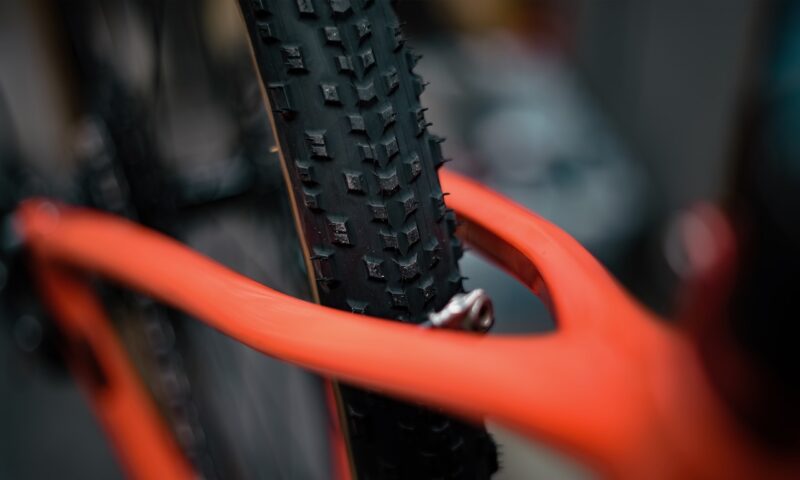
Conclusion
As the only part of the bike that makes contact with the ground, tires are an important part of the gravel equation. The team at Teravail says it has put several years into designing and testing the brand’s gravel tire line. The brand aims to accommodate riders of all disciplines and help them achieve the best performance on a variety of terrain types.
Check out its selection of all-terrain tires, designed for gravel riding, mountain biking, and bikepacking.
This article is sponsored by Teravail. Learn more about the brand’s tires online.
The post How to Choose a Gravel Tire with Teravail appeared first on Bikerumor.
from Bikerumor https://ift.tt/Y9Djh6E
via IFTTT



0 Comments